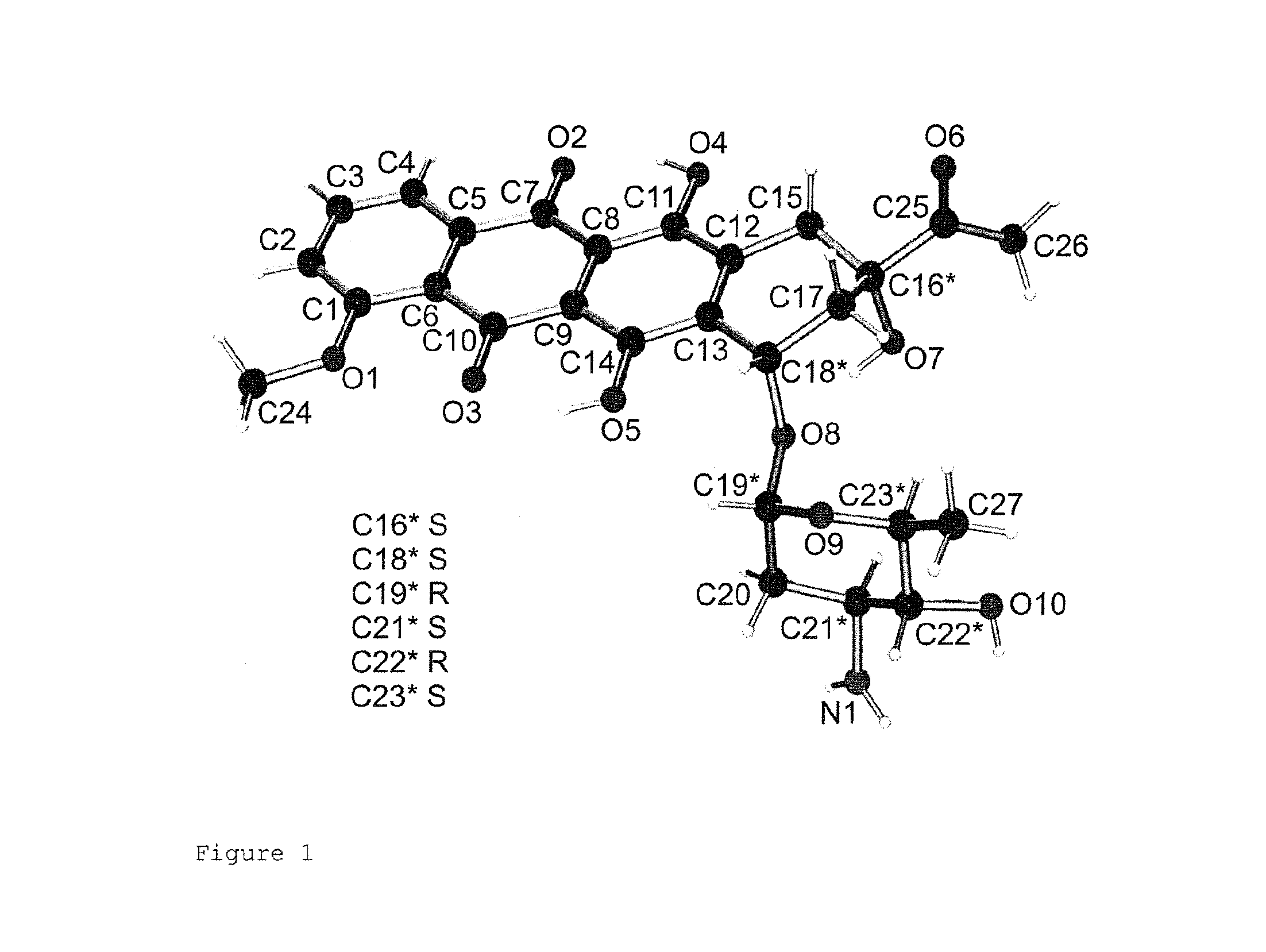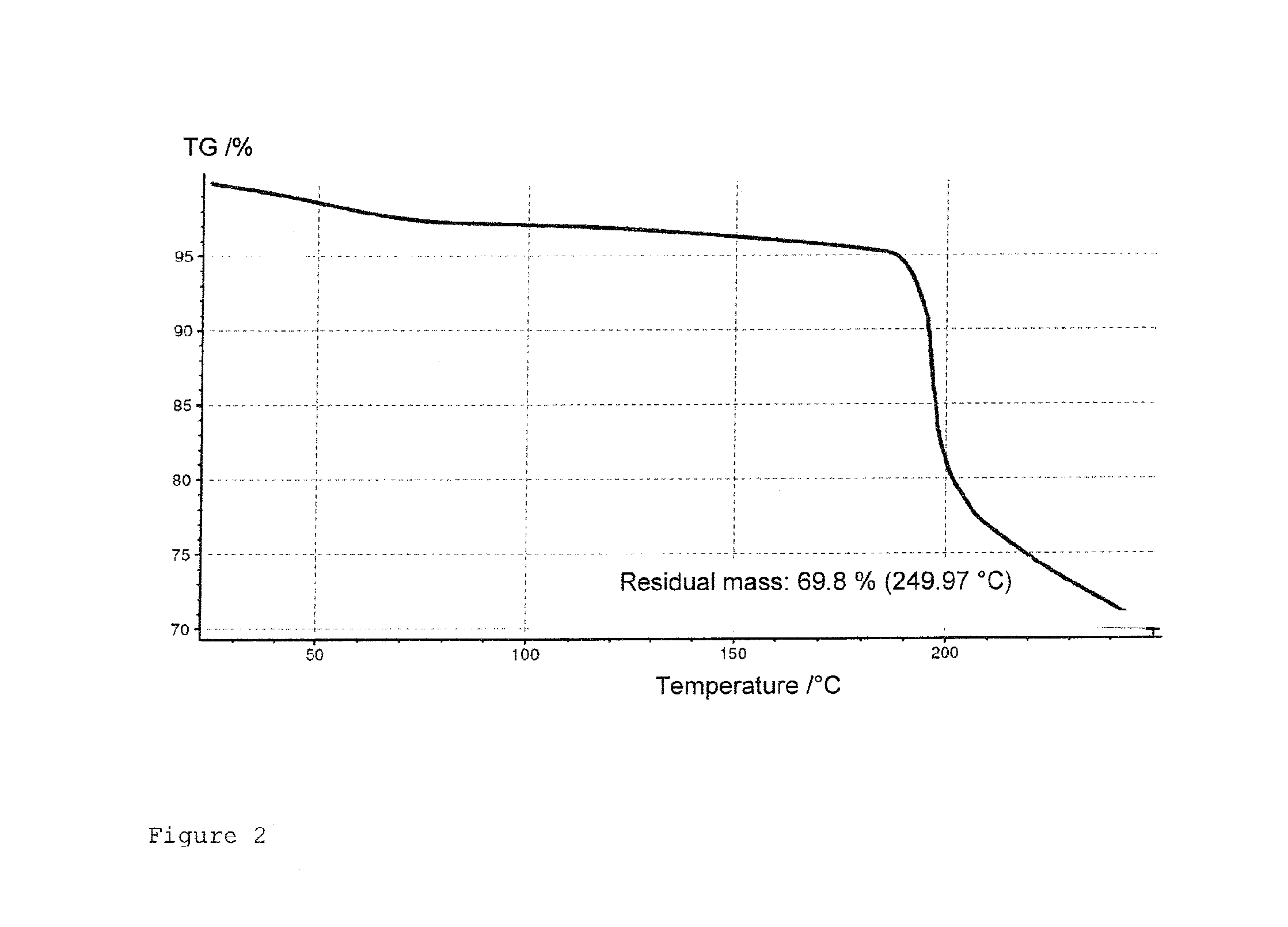Crystallization of 4′-epidaunorubicin hydrochloride
a technology of epidaunorubicin and hydrochloride, which is applied in the field of crystallization of 4′-epidaunorubicin hydrochloride, can solve the problems of only being soluble in precipitated 4′-epidaunorubicin hydrochloride and often purifying unsatisfactory, and achieves high purity, improved solubility, and excellent purity
- Summary
- Abstract
- Description
- Claims
- Application Information
AI Technical Summary
Benefits of technology
Problems solved by technology
Method used
Image
Examples
example 1
[0050]10 g 4′-epidaunorubicin hydrochloride were dissolved in a mixture of chloroform and butanol (ratio=2:1 by volume). To this mixture, 10-times the volume of a mixture of 1-propanol and 1-butanol (ratio=3:7 by volume) was added at 60° C. The end concentration of 4′-epidaunorubicin hydrochloride in the resulting solvent system was 8 g / l.
[0051]The mixture was cooled to room temperature within a period of 5 hours, and subsequently stirred for 12 hr at room temperature.
[0052]The resulting crystals were separated from the solvent mixture by means of filtration, washed with 50 ml tert-butyl-methylether and dried at vacuum (<400 mbar).
[0053]The crystals were analyzed and confirmed as 4′-epidaunorubicin hydrochloride. The yield was 9.2 g, the purity was 98.2%. The product decomposed at 191° C., the mass was 528 D.
example 2
[0054]10 g 4′-epidaunorubicin hydrochloride were dissolved in a mixture of chloroform and butanol (ratio=2:1 by volume). This mixture was slowly added to 10-times the volume of a mixture of 1-propanol and 1-butanol (ratio=3:7 by volume) at 60° C. The end concentration of 4′-epidaunorubicin hydrochloride in the resulting solvent system was 20 g / l.
[0055]The mixture was cooled to room temperature within a period of 5 hours, and subsequently stirred for 12 hr at room temperature.
[0056]The resulting crystals were separated from the solvent mixture by means of filtration, washed with 50 ml tert-butyl-methylether and dried at vacuum (<400 mbar).
[0057]The crystals were analyzed and confirmed as 4′-epidaunorubicin hydrochloride. The yield was 9.2 g, the purity was 98.2%. The product decomposed at 191° C., the mass was 528 D.
example 3
[0058]10 g 4′-epidaunorubicin hydrochloride were dissolved in a mixture of dichloromethane and 1-propanol (ratio=1:1 by volume). To this mixture, 10-times the volume of a mixture of 1-propanol and isopropanol (ratio=2.5:8 by volume) was slowly added at 60° C. The end concentration of 4′-epidaunorubicin hydrochloride in the resulting solvent system was 8 g.
[0059]The mixture was cooled to room temperature within a period of 5 hours, and subsequently stirred for 12 hr at room temperature.
[0060]The resulting crystals were separated from the solvent mixture by means of filtration, washed with 50 ml tert-butyl-methylether and dried at vacuum (<400 mbar).
[0061]The crystals were analyzed and confirmed as 4′-epidaunorubicin hydrochloride. The yield was 9.1 g, the purity was 98.0%. The product decomposed at 190° C., the mass was 528 D.
PUM
| Property | Measurement | Unit |
|---|---|---|
| concentration | aaaaa | aaaaa |
| concentration | aaaaa | aaaaa |
| temperature | aaaaa | aaaaa |
Abstract
Description
Claims
Application Information
 Login to View More
Login to View More - R&D
- Intellectual Property
- Life Sciences
- Materials
- Tech Scout
- Unparalleled Data Quality
- Higher Quality Content
- 60% Fewer Hallucinations
Browse by: Latest US Patents, China's latest patents, Technical Efficacy Thesaurus, Application Domain, Technology Topic, Popular Technical Reports.
© 2025 PatSnap. All rights reserved.Legal|Privacy policy|Modern Slavery Act Transparency Statement|Sitemap|About US| Contact US: help@patsnap.com


